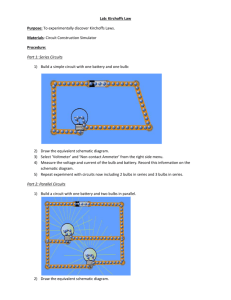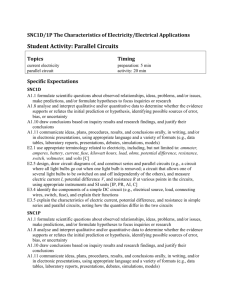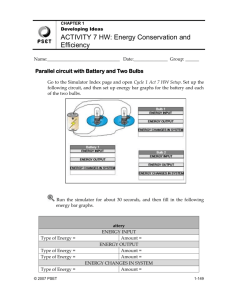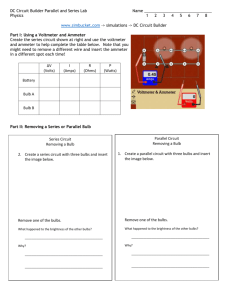high school physics teachers' forms of thought about simple electric
advertisement
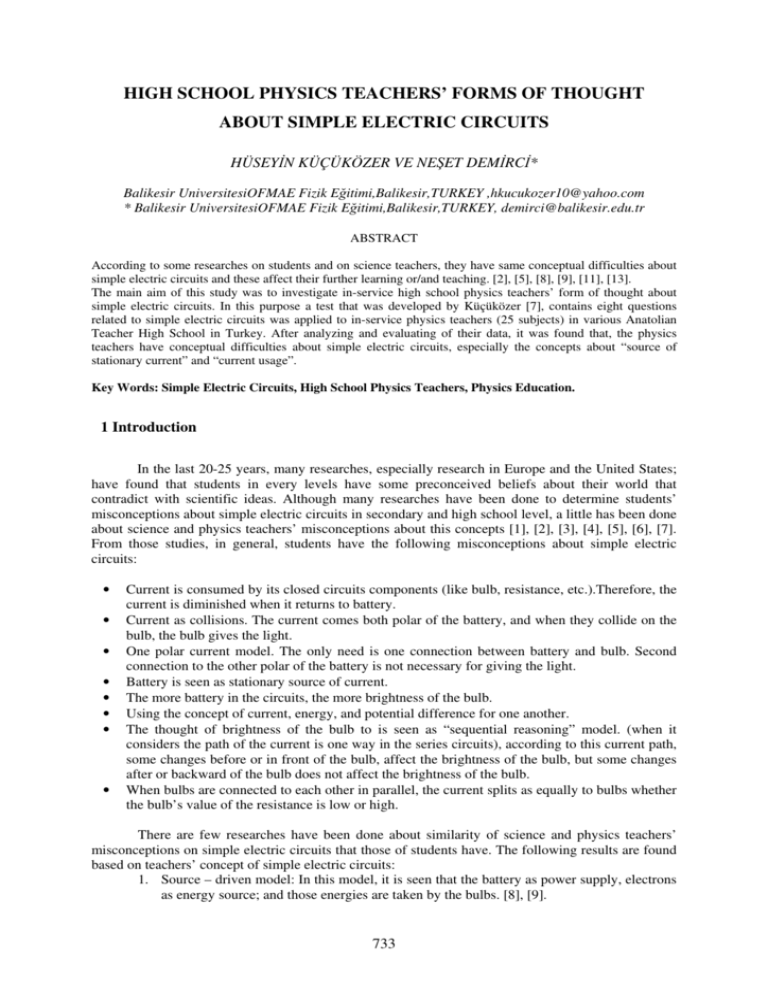
HIGH SCHOOL PHYSICS TEACHERS’ FORMS OF THOUGHT ABOUT SIMPLE ELECTRIC CIRCUITS HÜSEY N KÜÇÜKÖZER VE NE ET DEM RC * Balikesir UniversitesiOFMAE Fizik E itimi,Balikesir,TURKEY ,hkucukozer10@yahoo.com * Balikesir UniversitesiOFMAE Fizik E itimi,Balikesir,TURKEY, demirci@balikesir.edu.tr ABSTRACT According to some researches on students and on science teachers, they have same conceptual difficulties about simple electric circuits and these affect their further learning or/and teaching. [2], [5], [8], [9], [11], [13]. The main aim of this study was to investigate in-service high school physics teachers’ form of thought about simple electric circuits. In this purpose a test that was developed by Küçüközer [7], contains eight questions related to simple electric circuits was applied to in-service physics teachers (25 subjects) in various Anatolian Teacher High School in Turkey. After analyzing and evaluating of their data, it was found that, the physics teachers have conceptual difficulties about simple electric circuits, especially the concepts about “source of stationary current” and “current usage”. Key Words: Simple Electric Circuits, High School Physics Teachers, Physics Education. 1 Introduction In the last 20-25 years, many researches, especially research in Europe and the United States; have found that students in every levels have some preconceived beliefs about their world that contradict with scientific ideas. Although many researches have been done to determine students’ misconceptions about simple electric circuits in secondary and high school level, a little has been done about science and physics teachers’ misconceptions about this concepts [1], [2], [3], [4], [5], [6], [7]. From those studies, in general, students have the following misconceptions about simple electric circuits: • • • • • • • • Current is consumed by its closed circuits components (like bulb, resistance, etc.).Therefore, the current is diminished when it returns to battery. Current as collisions. The current comes both polar of the battery, and when they collide on the bulb, the bulb gives the light. One polar current model. The only need is one connection between battery and bulb. Second connection to the other polar of the battery is not necessary for giving the light. Battery is seen as stationary source of current. The more battery in the circuits, the more brightness of the bulb. Using the concept of current, energy, and potential difference for one another. The thought of brightness of the bulb to is seen as “sequential reasoning” model. (when it considers the path of the current is one way in the series circuits), according to this current path, some changes before or in front of the bulb, affect the brightness of the bulb, but some changes after or backward of the bulb does not affect the brightness of the bulb. When bulbs are connected to each other in parallel, the current splits as equally to bulbs whether the bulb’s value of the resistance is low or high. There are few researches have been done about similarity of science and physics teachers’ misconceptions on simple electric circuits that those of students have. The following results are found based on teachers’ concept of simple electric circuits: 1. Source – driven model: In this model, it is seen that the battery as power supply, electrons as energy source; and those energies are taken by the bulbs. [8], [9]. 733 2. Current as collision model. The current comes both polar of the battery, and than they collide on the bulb, as a result of this, the light gets [8], [9]. 3. Current as one polar model. The only need is one connection between battery and bulb. Second connection to the other polar of the battery to bulb is not necessary for getting the light on [8], [9]. 4. Current as equally sharing model. In the series circuits, the current is shared equally by the bulbs [8], [9]. 5. Current as sequential reasoning model. In the series circuits, some changes before or in front of the bulb, affect the brightness of the bulb, but some changes after or backward of bulb does not affect the brightness of the bulb [8]. 6. Current as mechanical model. In this model, it is seen that electrons moves as a mechanical particle in the wire; and this is the cause of the current [8], [10]. The main aim of the study is to determine high school physics teachers’ forms of thought about simple electric circuits. 2 Methods In this study, there was only one test to determine high school physics teachers’ forms of thought about simple electric circuits. This partly open ended test that was developed by using the some previous studies [11], [3] and [4] by Küçüközer [7] consists of eight questions and two parts. In the first part there are multiple-choice questions. In the second part there are open-ended questions related to the first part in which they are asked to explain their reasons why they have chosen their answers. 2.1 Sampling In the study there were 25 in-service physics teachers (3 of them were female and 22 of them were male) came from 25 different Anatolian Teacher High schools in Turkey (participated teachers in service course was chosen randomly from applicants of physics teachers) ranging their age between 26 to 49 years old and experience in their teaching between 5 to 24 years. 2.2 Collecting and Analyzing Data • • • • • • In the study there was one instrument, the concept test about simple electric circuits. The test had high reliability (r=0.75) coefficient (the multiple choice question part). To finish the conceptual test it is given to both groups 30 to 40 minutes. To analyze the data the following procedures was followed. First of all, participants’ correct answer was determined for each question. Then, these correct answers, according to their open-ended explanations, divided into two parts as being scientifically correct or wrong. And then, explanations of the scientifically correct answers were classified into two parts as being exact correct answer or partly correct answer. Next, explanations of the wrong answers were similarly classified into categories among the answers. Finally, after analyzing the correct and wrong answer and explanations, results were summarized into tables for each question. 3 Results In this part, due to the limited space, only three questions out of eight and their answers were analyzed. These three questions and their results are given as follow: 3.1 Stationary Current Sources 734 In the following question, it is aimed to determine participants’ thoughts about “batteries as stationary current source”. This question is given in figure 1 and related results are given in table 1. In the above figure the bulbs and batteries are identical. a) In the above figures the bulbs are connected as shown. Please choose one answer about the brightness of the bulbs and then explain your reasoning. A>B=C=D=E A=B=C>D=E A>B=C>D=E A=D=E>B=C ................................(if given choices are not correct, write your own choice here) A=B>C>D>E Explain your reasoning: ……………………………………………………………………………………………………………………………………………………………………………………………………………………………….. ………………………………………………………………………………………………………………………………………………………………………………………………………………………………. Figure 1: The third question in the test Question No 3 Number (Freq. In %) The Correct Answer is: A = D = E > B = C Scientifically Acceptable Correct Answers a) Exactly Correct answer 2 (8) - The brightness of the bulbs is proportional to power of the bulb (P=V2/R) b) Partly Correct answer In this answer, participants did not mention any of bulbs’ power but used to compare brightness according to bulbs’ potential differences. c) the correct answer but no explanation is given 16 (64) 4 (16) Wrong Answers 1) A > B = C > D = E In this answer participant focus on effective resistance and gave this answer: “Because of the total resistance, B and C less bright than A. Also the bulb of D and E less bright than the others.” - wrong answer but no explanation is given - 1 (4) 1 (4) 2) A = B = C > D = E In this choice participants have seen batteries as stationary current sources. 1 (4) Table 1: Participants’ results about the third question. It can bee seen in Table 1 that 88 % of the physics teachers marked the correct answer. 8% of them gave the exact correct answer with relating the brightness of the bulb with power of the bulb. 64 % just related the potential differences with the brightness of the bulb. For example, one teacher explained the exact correct answer like this “the brightness is proportional to power of the bulbs. The power is proportional to square of current (P=I2R). When one battery and bulb are in the circuit, if the main current was I, then when added the second bulb to circuit in series, the main current becomes I/2; when added the second bulb to circuit in parallel, the main current become 2I, but each bulb shares the current of I. According to given formula; therefore, the correct answer becomes B=C < A=D=E”. Most of the teachers gave the correct answer but stated their partially correct answer that 735 the brightness was proportional to potential differences of the bulbs, and they did not mention the power of the bulbs. For example, one teacher stated as: “the more potential differences, the more brightness. A, D, E have potential of V, and B and C have a potential of V/2; therefore the correct answer is B=C < A=D=E.” 12 % of the physics teachers have marked the wrong answers. When analyzing the wrong answer, it can be seen that 4 % of them has chosen the wrong answer that related the misconception of “battery is stationary current source”. This teacher has explained reasoning like this: “In series circuits the same current flow over the circuits, but in parallel circuits current are divided into two parts; therefore the more current gives the more brightness”. 3.2 Consume of current by circuit component To determine participants misconception about the concept of “circuits component have consume the current”, sixth question have been asked. This question and its results are given in Figure 2, and Table 2, respectively. In the following figure, what is the current between given 1and 2 points? Mark the correct answer and then explain your reasoning. Explain your reasoning: ……………………………………………………………………………………………………………………………………………………………………………………………………………………………….. ……………………………………………………………………………………………………………………………………………………………………………………………………………………………… Figure 2: Question 6 Question No 6 Number (Freq. In %) The correct answer is: 1 = 2 Scientifically Acceptable Correct Answer Exact correct answer - “Conservation of the current (in series circuits the current is the same all over of the circuits. The current does not change when it passes through the bulbs).” No explanation is given Wrong Choice 1) 1 < 2 Consume of the current 17 (68) 7 (28) 1 (4) Table 2: Participants’ results about the sixth question It can be seen in Table 2 that 96% of the physics teachers have marked the correct answer. Of the given correct answer, 68 % of the physics teachers gave the exact explanation of “conservation of the current” while 28 % of them did not give any explanation. We can infer that those physics teachers are not sure of what they are doing. 4% of the physics teachers have marked the incorrect answer. As the explanation of choosing the answer of (1<2), one teacher explained like this “the current has a big value when it closes the negative pole of the battery. Because, when the current passes through the bulb, the current is lessened” 3. 4 Using ammeter and voltmeter in circuits incorrectly To determine participants’ misconception about the concept of “using measurement devices incorrectly in the circuit (for example, to use ammeter instead of voltmeter)”, the seventh question has been asked. This question and its results are given in Figure 4, and Table 5, respectively. 736 In the following figures; the bulbs, resistances, and batteries are identical. Please rank the brightness of the bulbs, choose one answer and then explain your reasoning. I=II=V>III=IV I=IV=V, II and III do not give light I=II=V>III=IV I=II=III=IV=V V>I=II>III=IV .......................... Explain your reasoning: ……………………………………………………………………………………………………………………………………………………………………………………………………………………………….. ………………………………………………………………………………………………………………………………………………………………………………………………………………………………. Figure 4: The seventh question Question No 7 Number (Freq. In %) The correct answer is: I = IV = V, II and III does not give light Scientifically Acceptable Correct Answer a) Exact correct answer They know how to connect voltmeter and ammeter to the circuits. “When it is connected measuring devices incorrectly the bulbs do not give the light. In figure II and III the measuring devices are connected incorrectly; therefore they do not give the light. The others (I, IV, V) are connected correctly to the circuits; therefore, the connection does not affect the brightness of the bulbs; all of the bulbs have the same brightness.” b) Partially correct answer - “the voltmeter has a high internal resistance and ammeter has very low internal resistance” No explanation is given The wrong choices 1) I = II = III = IV = V The voltmeter and ammeter do not affect the brightness of the bulbs. - No explanation is given 2) I = II = V > III = IV - No explanation is given 7) no answer, wrong explanation - “the bulb of V is the brightest because of there is no ammeter or voltmeter. The bulbs of III and IV give the same brightness; because ammeter and voltmeter are connected to the circuit in parallel. I and II the same brightness; because ammeter and voltmeter are connected to the circuit in series”. No answer is given 9 (36) 5 (20) 4 (16) 2 (8) 2 (8) 1 (4) 1 (4) 1 (4) Table 3: Participants’ results about the seventh question It can be seen in Table 3 that 9 physics teachers (36%) gave the exact correct explanation. On the other hand, 12 % of physics teachers gave the incorrect explanations. When we look at the Table 3, it can be said that some part of physics teachers have some confusion about connecting measurement devices to electric circuits. 4 Conclusions and Recommendations 4.1 Conclusions 737 The main aim of the study is to determine high school physics teachers’ forms of thought about simple electric circuits. Summary of their wrong ideas is given in Table 4. Wrong believes - Current is consumed by its component. (4 and 6th question). - Batteries are seen as stationary current sources (the third question). - Using ammeter and voltmeter in circuits incorrectly (7th question). Number (frequency in %) 1 (4) 1 (4) 3 (12) Table 4: The summary of the participants’ wrong believes about electric circuits. It can be said from Table 6 that even though the high school physics teachers have very low percentage of wrong believes about simple electric circuits. As a result, high school physics teacher have some wrong believes about simple electric circuits. Finding of this study results have similarities those researches from the literature [8], [9],[12]. 4.2 Recommendations From this study results and experience the following recommendations can be made: • After determining students’ and/or teachers’ wrong believes about simple electric circuits, the teachers should be informed and have to aware of and overcome those kinds of misconceptions with arranging in service courses by ministry of education department as frequently as possible. • The physics teachers, instructors, or professors have to follow educational researches about their related topics or current physical issues or misconceptions to get up to date correct and useful information with using magazines, research papers, internet or what so ever any medium. • When explaining the brightness of the bulbs, physics teachers used potential difference and current concepts. Most of them did not mention even about power of the bulbs. They are asked to explain their reasoning, they blamed physics textbooks. The content and approach of the textbooks have to chosen very carefully. The publishers and authors must be very careful with publishing the physics textbooks. Bibliography [1] Kärrqvist, C. “The development of concepts by means of dialogues centered on experiments”. in: R. Duit, W. Jung, C. von Rhöneck (Eds), Aspect of Understanding Electricity, 73-83 (1985). [2] Lee, Y., and Law, N. “Explorations in promoting conceptual change in electrical concepts via ontological category shift”. International Journal of Science Education, 23 (2), 111-149 (2001). [3] McDermott, L. C.&. Shaffer, P.S. “Research as a guide for curriculum development: An example from introductory electricity, Part I: Investigation of student understanding”. American Journal of Physics, 60, 1003-1013 (1992). [4] Shipstone, D. M., Rhöneck, C.V., Kärrqvist, C., Dupin, J., Johsua, S., and Licht, P. “A study of student’ understanding of electricity in five European countries”. International Journal of Science Education,10 (3), 303-316 (1988). [5] Osborne, R., “Towards modifying children’s ideas about electric current”. Research in Science and Technological Education, (1) 1, 73-83 (1983). [6] Tiberghien, A., “Critical review on the research aimed at elucidating the sense that the notions of electric circuits have for students aged 8 to 20 years”. International summer workshop: Research on Physics Education, La Londe les Maures-France (1983). [7] Küçüközer, H., “Lise I ö rencilerinin basit elektrik devreleri konusuyla ilgili kavram yanılgıları”. Hacettepe Journal of Education, 25:142-148 (2003). [8] Pardhan, H., Bano, Y. “Science teachers’ alternate conceptions about direct-currents”. International Journal of Science Education, 23, (3), 301-318. (2001). [9] Webb, P., “Primary science teachers’ understanding of electric current”. International Journal of Science Education, 14 (4), 423-429 (1992). [10 ]Stocklmayer, M. S., and Treagust, D.F. “ Images of electricity: how do novices and experts model electric currunt” International Journal of Science Education,18 (2), 163-178 (1996). [11] Shipstone, D. M., “On childrens’ use of conceptual models in reasoning about current electricity”, in: R. Duit, W. Jung, C. von Rhöneck (Eds), Aspect of Understanding Electricity, 73-83. (1985). [12] Engelhart, P. V., and Beichner, R. J. “Students’ understanding of direct current resistive electrical circuits.” American Journal of Physics, 72 (1), 98-115 (2004). [13] Driver, R., and Erickson, G. “Theories-in action: Some theoretical and empirical issues in the study of students’ conceptual frameworks in science”. Studies in Science Education, 10, 37-60 (1983). 738

